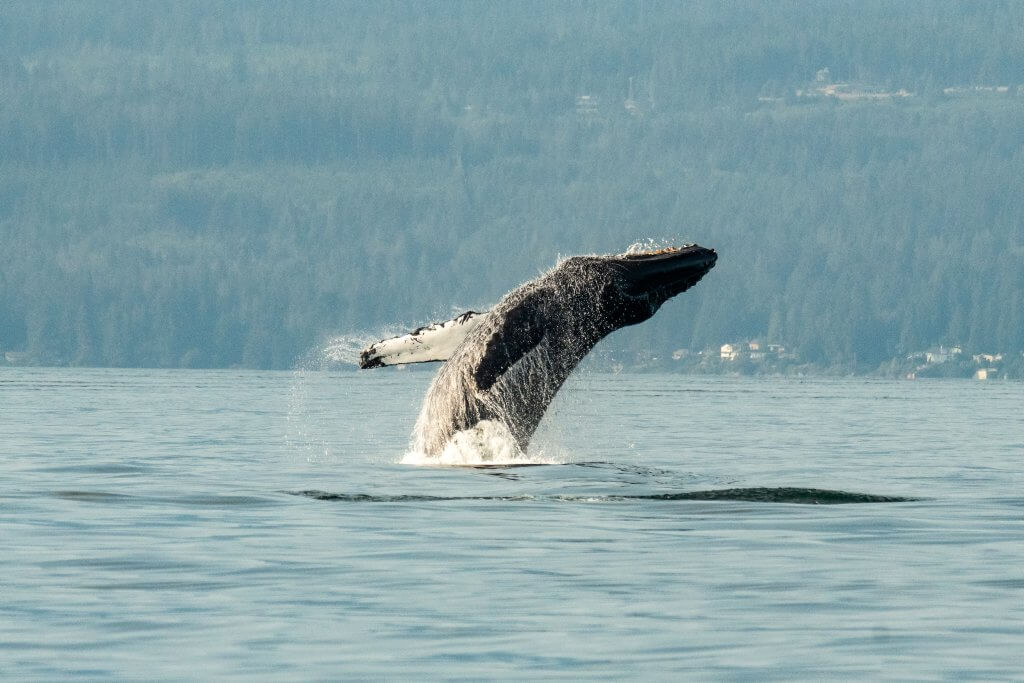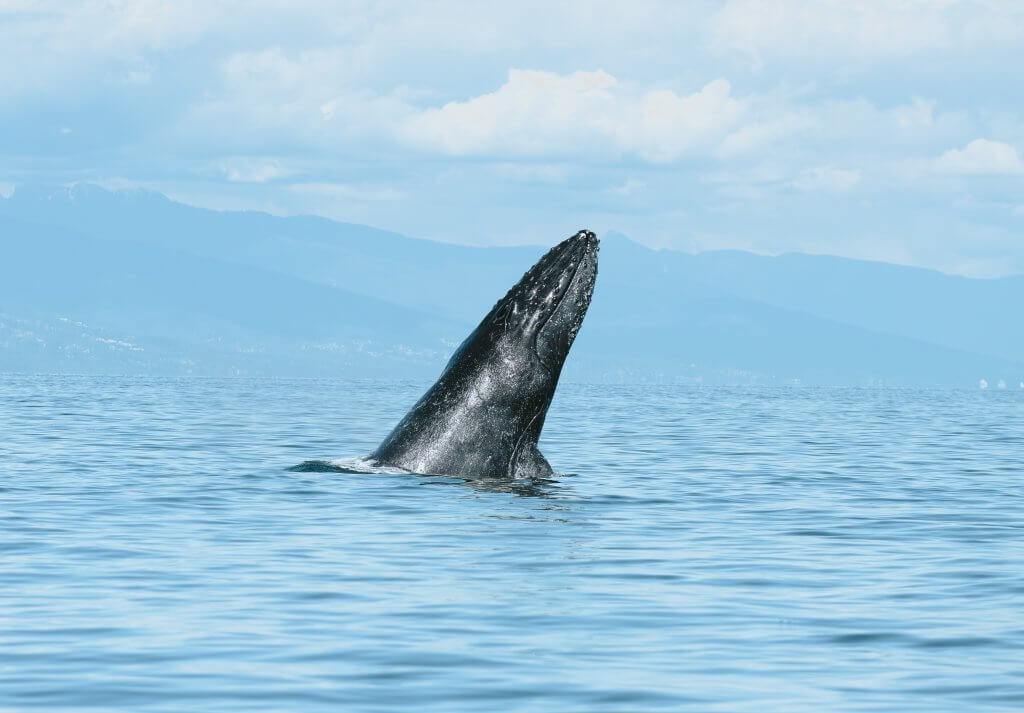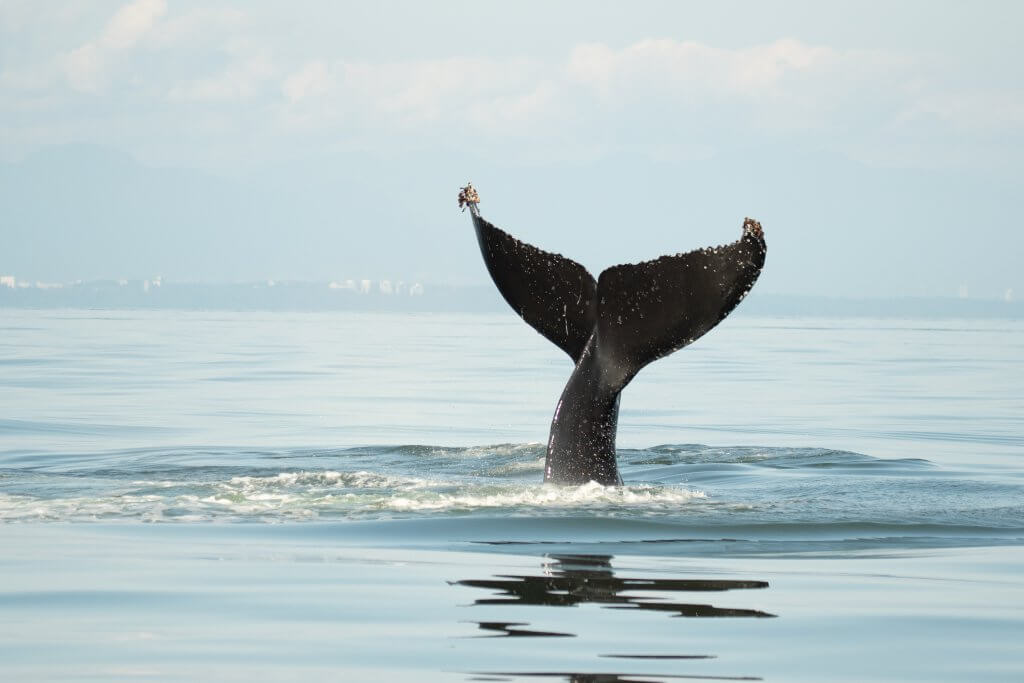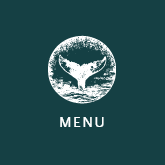Vancouver’s waters come alive each year with the magnificent presence of humpback whales, creating unforgettable experiences for wildlife enthusiasts with Wild Whales Vancouver. These gentle giants return to the nutrient-rich coastal waters from spring through fall as part of their annual migration pattern. The waters surrounding Vancouver have become an increasingly popular destination to witness these massive marine mammals, with growing populations spending their entire summer feeding in British Columbia.

Departing from Granville Island we are lucky to be straight into humpback viewing waters when leaving English Bay. Our tours offer opportunities to see not only humpbacks but also other species like orcas, gray whales, and minkes. Their acrobatic behaviors—including breaching, lunge feeding, and pectoral slapping—make humpbacks particularly thrilling to observe in their natural habitat on a Wild Whales tour.
Key Takeaways
- Humpback whales migrate to Vancouver’s nutrient-rich waters seasonally, offering prime viewing opportunities from spring through fall with Wild Whales Vancouver.
- Wild Whales Vancouver operates in the Vancouver area, providing tours that regularly encounter these magnificent marine mammals.
- Conservation efforts have helped humpback whale populations recover in British Columbia waters, creating more reliable wildlife viewing experiences with Wild Whales Vancouver.
Humpback Whale Migration

Humpback whales undertake one of the longest migrations of any mammal, traveling thousands of miles between their feeding and breeding grounds each year. These magnificent creatures follow predictable routes that bring them to Vancouver waters during specific seasons, creating perfect opportunities for Wild Whales Vancouver’s guests to observe them.
Routes and Destinations
Humpback whales (Megaptera novaeangliae) are strongly migratory creatures with impressive travel patterns. They spend winters in warm tropical waters of Hawaii and Mexico where they breed and give birth to calves, before making their way to the waters that Wild Whales Vancouver explores.
During spring, they begin their incredible journey northward to reach the nutrient-rich feeding grounds of Alaska and British Columbia. This round trip can total up to 5,000 miles annually, as Wild Whales Vancouver’s naturalists often explain to fascinated guests!
The journey isn’t a quick simple north-south route – they follow complex patterns tied to ocean currents and food availability. These giants travel at a relatively leisurely pace of about 3-9 miles per hour, making their seasonal treks truly epic voyages that Wild Whales Vancouver helps visitors appreciate.
Significance of Vancouver Waters
Vancouver Island and British Columbia coastal waters serve as crucial pit stops and summer feeding grounds for migrating humpbacks. The nutrient-rich waters around Vancouver create perfect conditions for krill and small fish to thrive, essential food for hungry humpbacks, making this a prime location for Humpback whales.
The best time to spot these magnificent creatures around Vancouver with Wild Whales Vancouver is from May to October when they’re actively feeding in the area. This feeding period is vital for building up their blubber reserves before the long journey south to their breeding grounds in the winter time.
The Salish Sea has become an increasingly important habitat for humpbacks, with growing numbers returning each year. Their presence indicates the health of these waters and their importance within the North Pacific ecosystem, a conservation success story.
Whale Watching in Vancouver

Best Practices and Regulations
When whale watching with Wild Whales, we ensures all proper guidelines are followed to protect these magnificent creatures. All of our vessels maintain a minimum distance of 100 meters from most whales and 200 meters from killer whales to minimize disturbance to their natural behaviors.
Our captains are trained to maintain regulated distances at all times and approach whales from the side in a slow and controlled manner. This reduces stress on the animals and ensures their feeding patterns aren’t disrupted, demonstrating Wild Whales Vancouver’s commitment to responsible wildlife viewing.
Our highly educate Naturalists will let guests know about conservation efforts while enforcing regulations. These experts help visitors understand the importance of the guidelines that protect these maritime animals during every tour.
Identifying Humpback Whales
Humpback whales are easily distinguished by their massive size (40-50 feet long) and characteristic behaviors. Their most recognizable feature is their distinctive tail flukes, which are as unique as human fingerprints, our guides often point out different patterns to help guests identify individual whales.
Scientists use identification photographs of these flukes to track individual whales, estimate abundance, and monitor migration patterns. Scarring and natural markings help to identify specific animals, some that become well known to people in the Salish sea. Wild Whales Vancouver helps support this data through their sighting reports.
When watching for humpbacks with Wild Whales Vancouver, look for their bushy, tall straight blow that can reach 10 feet high. Their spectacular surface behaviors that Wild Whales Vancouver often witnesses include:
- Breaching: Leaping partially or completely out of water
- Lunge feeding: Surging forward with open mouths to capture prey
- Pectoral slapping: Slapping their huge front pectoral flippers on the water
You might also witness them dive deep for food, displaying those magnificent flukes above the water that photographers love to capture.
Whale Watching Tips and Tours
Tours range from 3-5 hours in length and depart from Granville Island in Vancouver, with prices ranging from $179-189 per adult.
We recommends dressing warmly in layers even on sunny days, as temperatures on the water can be significantly cooler. We suggest bringing binoculars, sunscreen, and a camera with a zoom lens for the best experience.
Many tours also spot killer whales, grey whales, bald eagles, sea lions, and porpoises. The Georgia Strait area and waters around Vancouver are particularly rich with marine life that Wild Whales Vancouver expertly navigates.
Frequently Asked Questions
When is the best time to see humpback whales?
While humpback whales can be seen as early as April, prime viewing season runs from May to October. During these months, the waters around Vancouver host migrating humpbacks in greater numbers, maximizing opportunities on encountering these magnificent animals.
Both morning and afternoon tours offer the same opportunity to view the same wildlife, with the morning offering a cooler temperature while afternoon excursions may benefit from warming temperatures, giving guests options to suit their preferences.
What are the chances of spotting a humpback whale on a Vancouver whale watching tour?
The chances of seeing humpback whales are excellent during peak season. About 50% of whale sightings in the area are humpback whales in peak season, with orcas making up the remaining 50% of sightings on tours.
We are so confident in wildlife encounters that they guarantee whale sightings or offer a free return trip if no whales are spotted during your excursion.
Why is there an increase in humpback whale sightings near Vancouver?
Humpback whale populations have been steadily recovering since commercial whaling was banned in 1966. Their numbers in the North Pacific have increased from approximately 1,400 to over 21,000 today, a conservation success story that Wild Whales Vancouver celebrates.
Improved water quality and stricter marine protection regulations have helped create a healthier ecosystem around Vancouver. This environmental improvement has resulted in more abundant food sources for humpbacks, enhancing the viewing opportunities on Wild Whales Vancouver tours.
Each year more humpback whales are returning with new calves which will continue to return year after year to feed. With a rise in available food source, more humpback whales will remain in the Salish sea for their whole feeding season.

